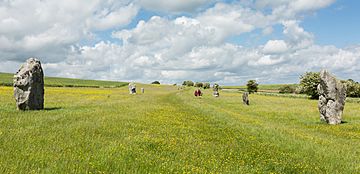Kennet Avenue facts for kids
| UNESCO World Heritage Site | |
|---|---|

Kennet Avenue in 2014
|
|
| Location | Wiltshire, United Kingdom |
| Part of | Avebury Section of Stonehenge, Avebury and Associated Sites |
| Criteria | Cultural: (i), (ii), (iii) |
| Inscription | 1986 (10th Session) |
| Extensions | 2008 |
Kennet Avenue, also known as West Kennet Avenue, is a very old, prehistoric site in Wiltshire, England. It was once a long path made of two parallel lines of standing stones. This stone path was about 25 meters (82 feet) wide and 2.5 kilometers (1.5 miles) long. It connected two important Neolithic (New Stone Age) sites: Avebury and The Sanctuary.
Contents
Discovering Kennet Avenue's Secrets
In the 1930s, archaeologists Stuart Ernest Piggott and Alexander Keiller dug up parts of Kennet Avenue. Their work showed that there were once about 100 pairs of standing stones lining the path. These stones were placed around 2200 BC. They found this out by discovering burials from the Beaker culture under some of the stones. Today, many of these ancient stones have either fallen over or are completely missing.
Bringing the Stones Back Up
During their excavations, Keiller and Piggott helped to set some of the fallen stones upright again. Another archaeologist, Maud Cunnington, had also done similar work on the avenue before them.
Protecting This Ancient Path
Kennet Avenue is part of the Stonehenge and Avebury World Heritage Site. This means it's recognized as a very important place globally. The land where the avenue stands is owned by the National Trust, a charity that protects historic places. It is also a scheduled monument, which means it's a nationally important archaeological site. The National Trust manages the site, working with English Heritage to care for and maintain this special piece of history.
Images for kids
See also
 In Spanish: Avenida Kennet para niños
In Spanish: Avenida Kennet para niños



